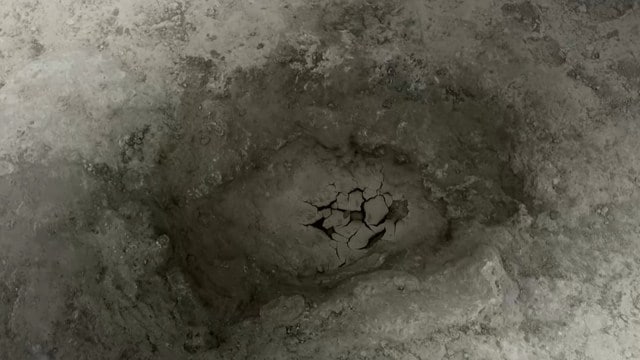Stay updated with the latest - Click here to follow us on Instagram
‘Insanely big footprints’ reveal superhighway trailed by dinosaurs in UK
The footprints will provide answers to questions such as how did the dinosaurs interact about 166 million years ago? Were they alone, or in a herd, being chased, or simply strolling?
 Covered by tonnes of rock, the dinosaur superhighway extends 220 metres, making it one of the longest trackways ever found. (Photo: Screengrab from Reuters YouTube Video)
Covered by tonnes of rock, the dinosaur superhighway extends 220 metres, making it one of the longest trackways ever found. (Photo: Screengrab from Reuters YouTube Video)An excavation in United Kingdom’s Oxfordshire quarry has uncovered one of the longest trackways of the world, used by a sauropod dinosaur, probably Cetiosaurus, that roamed the Earth 166 million years ago, according to BBC.
Covered by tonnes of rock, the dinosaur superhighway extends 220 metres, making it one of the longest trackways ever found. “These footprints are insanely big,” Emma Nicholls from Oxford University’s Museum of Natural History explained.
Many scientists and experts like Nicholls from across the UK reached the Dewars Farm Quarry to unearth the footprints, surrounded by trucks, diggers, and tippers, as per the report.
“We’re uncovering something that people have never seen before,” says University of Birmingham palaeontologist Kirsty Edgar. “It’s so rare to find something this big.”
How did the dinosaur dig begin?
A controlled explosion in the quarry removed millions of years of limestone rock, allowing the palaeontologists to excavate each sunken footprint, in an extremely delicate manner.
What emerged were several trackways, however, one of them — the dinosaur superhighway — continued to trail over hundreds of metres, Peter Falkingham from Liverpool John Moores University told BBC.
What all have the scientists found?
The scientists discovered massive footprints of the sauropod dinosaur, characterised by its four-legs, a long neck, plant-eating habits, that could reach about 18 m in length.
The trail marked by distinct footprints of the dinosaur extended from one end of the quarry to another, with hollows made by the front foot, followed by an “even bigger back foot sinking into the same plot.”
Another characteristic feature of the footprints are that they measure about 1 m in width, that is, twice the diameter of that of an elephant’s, BBC highlighted.
The palaeontologists also found smaller footprints, likely made by a two-legged carnivorous dinosaur called Megalosaurus. These creatures, measuring up to 9 m-long, left a distinctive three-toed mark as they prowled across the Jurassic terrain, BBC reported.
A site of this scale – especially in the UK – is a spectacular discovery, Dr Nicholls said.
“Even after being a palaeontologist for over 20 years, it still gives you that tingling feeling to see these footprints,” she said. “It’s humbling.”
Analysis of the footprints
Analysing the footprints in his lab, Prof Falkingham recreated a 3D-model of the sauropod dinosaur that trailed the track. Speaking to the BBC, he explained: “It’s not moving particularly fast, two metres per second. It’s about the same speed as a human would walk quickly – in this case it’s a stroll.”
What stands out for him is one of the footprints, which appears to be out of line with the others. Describing his assumptions, the professor highlighted, “It seems that for a moment – 166 million years ago – the dinosaur stopped and leant on one leg. Maybe it stuck a foot out because it slipped? Or maybe it heard something and turned to check it was safe?”
Meanwhile, Duncan Murdock of Oxford’s Museum of Natural History, has been using a “magnifying glass” to stare at a tiny patch of the quarry land.
“We’ve got little seashells – things like bivalves and brachiopods… Right here is a little belemnite, which is a squid-like animal that was swimming through the water,” he explained to the BBC.
“And we found this little sea urchin. It’s got this one spine that’s broken off, otherwise it’s an almost complete little, tiny sea urchin,” he added.
The Jurassic Oxfordshire was affected by higher sea levels, now enabling scientists to find evidence of marine life.
Establishing its similarity with the present-day Bahamas, or Florida Keys, Murdock said, these findings will inform scientists about the seascape where the dinosaurs walked.
Future research prospects
The tracks serve as an incredible source for palaeontologists to carve out information about fossils.
The footprints will provide answers to questions such as how did the dinosaurs behave and interact about 166 million years ago? Were they alone, or in a herd, being chased, or simply strolling?
Past discoveries
Last year, the quarry workers in England discovered some 200 clawed footprints of a 30-feet-tall predator and the sunken tracks of other dinosaurs, the New York Times reported.
A trail of five distinct footprints was uncovered in the Oxfordshire quarry, about 60 miles northwest of London, and belonged to both herbivores and carnivores that roamed the area during the Middle Jurassic period.
Palaeontologists then termed the discovery as one of the most significant finds in Britain in nearly three decades, as per the NYT report.
Since 1997, when the area was first excavated, scientists have found more than 40 sets of footprints across nearly 200 yards of pathways, calling the pathway as the “dinosaur highway”.
In 2023, palaeontologists from the University of Birmingham and Oxford visited the quarry, and found clawed, three-toed footprints of a megalosaurus, which walked on its hind legs, the report mentioned.
During their visit, they also found four footprints likely of a herbivorous sauropod, which were more than three feet long and one and a half feet deep, according to Edgar. “We’re getting a kind of snapshot of what these multiple animals were doing in life,” Edgar told NYT.





- 01
- 02
- 03
- 04
- 05


























